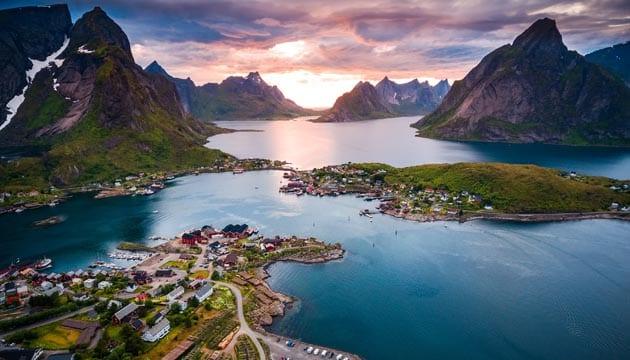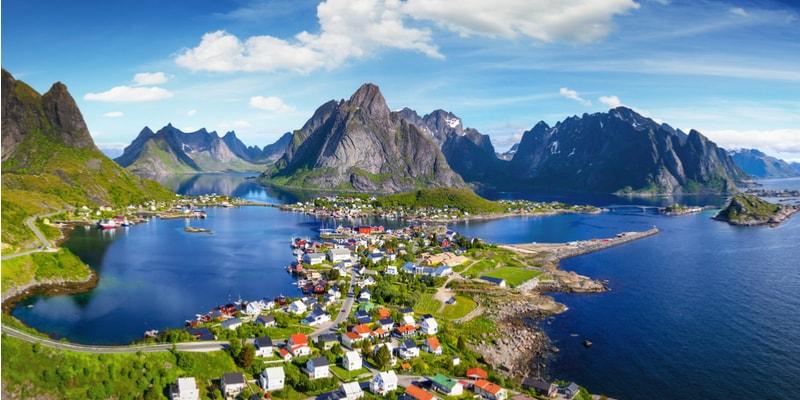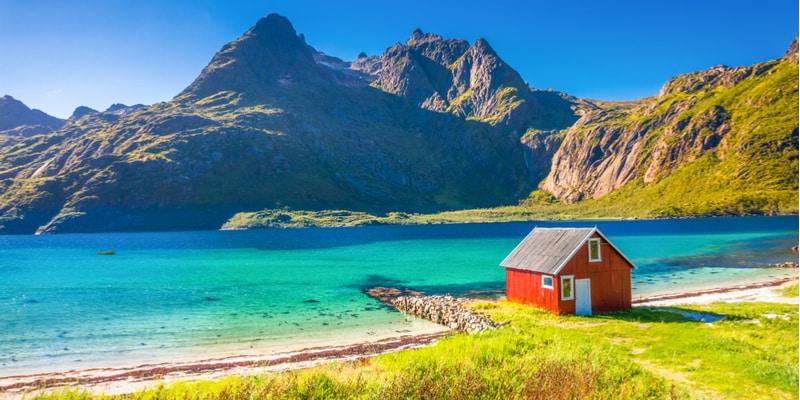A fairytale landscape of water, land and light where the nights sparkle with the midnight sun and the northern lights. The Lofoten Islands are an archipelago in Norway, stretching northwest between the counties of Nordland and Troms.
They lie about 200 km above the Arctic Circle, but have a much more temperate climate than many other places at the same latitude, thanks to the influence of the Gulf Stream. The Lofoten Islands captivate with their strikingly beautiful landscape: breathtaking fjords, majestic mountains and sheer cliffs between which hide fishing villages dating back to the Viking era.
The archipelago has a total area of 1,227 km² and a population of around 25,000. The main islands are Austvågøy, Gimsøy, Flakstadøy, Varøy, Vestvågøy, Moskensøy and Røst. They are separated from the mainland by Vestfjorden, but are all connected by bridges and scenic roads. You can move from island to island by kayak to slowly admire this Nordic paradise in the Norwegian Sea from the water. But also go fishing for Nordic cod, skiing, hiking, rafting, surfing or diving. Because nature is king here. The Norwegian poet, writer and playwright, Bjørnstjerne Bjørnsons, was right when he said: 'Youcannot say you have seen nature in its authenticity if you have not been to Norway first, and the most beautiful place is the Lofoten Islands'.
The Norwegian archipelago has also been certified as a Sustainable Destination for its efforts to reduce the negative impact of tourism. So all that remains is to explore them, and in the meantime we'll take you there.
Here is what to see in the Lofoten Islands.
Lofoten Islands, what to see?
Henningsvær
Reine
Nusfjord
Svolvær
Røst
Å
Lofotr Viking Museum
Værøy
Haukland Beach

Henningsvær
Henningsvær is one of the most popular resorts in the Lofoten Islands that has managed to preserve the charm of its original environment. Henningsvær is the archipelago's best-known fishing station, also called 'the Venice of the North', where the world's largest cod can be caught in winter. The small harbour was built on a group of islets at the foot of a cliff overhanging the sea. The village is connected to the main island by a bridge. Behind the harbour you can see a colourful group of wooden cottages, which were once fishermen's dwellings and fish-processing rooms. To reach Henningsvær, you drive along a beautiful scenic road that runs alongside the sea and crosses two bridges. Continuing along this road, you will also find the famous Henningsvær Stadium, one of the most photographed in the world due to its unique location.
Reine
Some call it the most beautiful village in Norway. Reine is a fishing harbour located southwest of the town of Moskenes on the island of Moskenesøya. It is a place that enchants due to its location at the foot of steep cliffs in the Norwegian fjords. In the past it was one of the main ports for sea trade, today it has just 300 inhabitants. It is one of the most remote places in Norway, but today tourism is the main occupation of the residents who once lived exclusively from fishing and the cod trade.
The village consists of the rorbuer, typical red cottages now converted into cottages for tourists. For art lovers, the Reine Culture Centre houses a permanent exhibition by artist Eva Harr and temporary installations. Hiking enthusiasts, on the other hand, will want to climb to the summit of the Reinebringen mountain. From the mountain peaks of Reine, one can also admire the Moskstraumen, a maelstrom-like phenomenon caused by the tide along the Atlantic coast of Norway. In Reine, you can also go kayaking or take a ferry to the beautiful beach of Bunes or Moskenes, another scenic village in Nordland County.

Nusfjord
Nusfjord is one of the oldest and best-preserved fishing villages in Norway. Located in the municipality of Flakstad, Nusfjord has been designated by Unesco, in agreement with the Norwegian government, as a pilot project to preserve traditional Norwegian architecture. Nusfjord, therefore, is not a permanently inhabited village but rather a museum. However, it is possible to stay in a traditional rorbu. Nusfjord is also a journey back in time. Archaeological excavations have uncovered settlements dating back to the 5th century. It was also one of the first places where cod processing was developed on an industrial scale in the Nordland region. You will see two processing plants and fifty historical buildings.
Svolvær
Svolvær is the capital of the Lofoten Islands and one of the most populated towns, with about 4,000 inhabitants. It is also considered to be the oldest city in the Arctic Circle, and dates back to the Viking period, although some archaeological finds suggest that it originated between 3000 and 4000 BC. Svolvær is located on the south coast of Austvågøy, one of the largest islands of the archipelago.
The town overlooks the Norwegian Sea and is protected by mountains. The most famous is Svolværgeita, which was climbed for the first time in 1910. It is a culturally active town and has several schools, art galleries and theatres. The Lofoten Krigsminnemuseum is the museum dedicated to World War II for those who want to relive history. At the end of the day, don't miss a drink at Magic Ice Lofoten, an ice bar. Like the other Lofoten towns, Svolvær is also linked to fishing and fish farming. Svolvær is the ideal starting harbour for exploring the archipelago. Excursions to admire the northern lights, whales, sea eagles and the beautiful fjord landscapes depart from here.
Røst
Røst is one of the southernmost municipalities in Lofoten and the smallest municipality in Norway. Røst comprises 365 islands and reefs in the wild southern end of the archipelago. Unlike the mountainous environment of the rest of Lofoten, Røst is characterised by a flat landscape, with the exception of a hill on the main island, Røstlandet, dotted with small lakes. The island is also known for the story of Pietro Querini, a navigator and merchant from a noble Venetian family, who was shipwrecked on a small island off Røst in 1432. Rescued by some fishermen, Querini and the surviving crew were guests of the local community. In the village he discovered stockfish. Once back home, he told of Lofoten and the drying of cod. This story is credited with starting the trade of stockfish and cod from Norway to Italy, a country that today consumes more than 90% of Norwegian fish.
Å
It is the country with the shortest name in the world. It is located in the municipality of Moskenes and consists of only one letter, Å.
It is often referred to as Å i Lofoten to distinguish it from other Norwegian countries called in the same way. In the Norse language Å means 'little river', but the curious thing is that Å is the last letter in the Norwegian alphabet and the town is the last of the Lofoten villages, which can be reached by following the European Road E10. The village of 150 inhabitants traditionally specialised in fishing and now houses the stockfish museum and the Norwegian Fishing Village Museum.
Lofotr Viking Museum
It is worth visiting Borg on the island Vestvågøya where the Lofotr Viking Museum is located. It is the largest Viking-era house ever found, an impressive structure reconstructed to actual size, just off the site of the original house. Here you can embark on a thousand-year journey in a living museum. You can take part in a Viking festival with singing, dancing and traditional dishes. In the summer, you can row a Viking ship, shoot a bow and arrow and participate in other activities of the era. A fun experience for the whole family. Next to the chief's house, modern exhibitions are set up with archaeological finds and on the history of Borg. In August, Borg hosts a five-day Viking festival with markets, shows, games, competitions and concerts.
Værøy
Værøy is a small island in the Lofoten archipelago. It is known for being the northernmost point on Earth without a meteorological winter. Despite being north of the Arctic Circle, the average temperature does not fall below zero during the cold months. This is due to the Gulf Stream that mitigates the waters. The island has about 800 inhabitants, most of whom live in the town of Sørland and on the flat farmland in the mountains.
After visiting the village of Sørland, explore the island's many white sandy beaches, including Nordlanshagen beach, Sørlandshagen beach or Punn Sanden beach, which can only be reached from the sea. Those who enjoy hiking can climb to the top of Heia or hike the island's many trails.
Haukland beach
Haukland beach is one of the most famous beaches in Lofoten, located in the western part of the archipelago. The crystal-clear waters, the mountain scenery in the background and its white sandy beach make Haukland Beach a popular destination for travellers and photographers all year round. Haukland is a beach where one can swim, although the water temperature varies from 3 to 15 degrees. It is also easily accessible from the access road.

What to do in Lofoten
Nature is the real star of the Lofoten Islands, to be admired at any time of the year. But there is a very special moment, when the northern lights illuminate the night and are reflected in the water. Lofoten lies just below the auroral oval, an elliptical band around the earth's magnetic poles, which demarcates the area with the best chance of spotting the polar auroras. The best times to see the aurora borealis are therefore winter and early spring.
Another spectacle of nature is the midnight sun: an incredible phenomenon that occurs in summer when the days are so long that the sun never sets behind the horizon. It can be admired in Norway, but not everywhere: only north of the Arctic Circle, such as on the Lofoten Islands, from 28 May to 14 July.
Not to be missed in Lofoten is a cruise through the fjords.
There are numerous tours departing from ports on all the islands that will let you discover this fabulous archipelago from the water. Fixed stops on many tours are the Øyhellsundet strait or the magical Trollfjord, where the mountains stretch 1000 metres high. Along the way, with a bit of luck, you may encounter sea eagles, even just a few metres from the boat. You will see white sandy beaches, majestic peaks and pristine landscapes as you cruise through magnificent fjords. There are also whale-watching cruises. Or you can go fishing with Lofoten fishermen in traditional boats. Finally, Lofoten is also one of the best surfing sites in Norway, and one of the northernmost in the world.
Those who prefer to explore the islands by land can go trekking. A landscape such as Lofoten, full of rugged peaks, summits and overhangs offers wonderful hiking. There are many paths to walk. One of the most beautiful islands for trekking is Vestvågøy, where you reach the summit of a mountain about 700 metres above sea level. You can also make small stages on what is considered the Lofoten tourist route: an 11-part 230-kilometre route that starts in Raftsundet in mainland Norway. Finally, there is the trek that connects two of the most beautiful beaches in the archipelago: Uttakleiv and Haukland. It is about 4 kilometres long and follows the path around Mount Veggen along the coast.
What to eat in Lofoten
Norway is famous for fishing and preparing high-quality fish, such as Nordic cod and salmon. So try the typical dishes made from these fish, but don't miss the marinated whale.
Norway is also renowned for its meat, such as lamb, which is considered among the best in the world. Norway's fenalår is now a geographically protected designation for cured leg of lamb, based on the long Norwegian tradition of hanging legs of mutton to dry in the mountain air for use during the winter. Try pinnekjøtt, lamb or mutton chops cured in brine or sea salt, smalahove (sheep's head), as well as elk, venison, reindeer and grouse meat. Also worth trying are cheeses such as brunost, caramelised brown cheese, gamalost and pultost. Also not to be missed are sweet berry delicacies, waffles and lefse (soft waffle made of flour, potatoes, milk and butter). Drinks include schnapps, Norway's national drink, and Gløgg, mulled wine that Norwegians make with a syrupy herbal mixture, to which almonds and dried sultanas are added.
How to get to Lofoten and how to travel between the islands
There are several ways to reach the Lofoten Islands. By plane, for example, with a stopover in Oslo you can reach Bodø, from where flights to the other islands depart. By train one can arrive in Stockholm, Kiruna and Narvik, and from there take a bus or hire a car to reach the islands. Those arriving in Oslo have the option of travelling by train to Bodø. For those who prefer the ship, there are ferries with daily departures all year round between Bodø, Svolvær and Værøy. Several car ferries depart from Bodø to many destinations in Lofoten. Once there, one can get around by public bus or by hiring a car.
Those looking for an on-the-road trip can take the Lofast (E10), the scenic road that crosses the islands, which are otherwise connected by ferries.
When to go to Lofoten
Thanks to the warm Gulf Stream, the climate in Lofoten is much milder than in other parts of the world at the same latitude. Despite being about 200 km from the Arctic Circle, the islands boast mild winters and relatively cool summers. January and February are the coldest months, with an average temperature of -1° C. July and August are the hottest, with an average temperature of 12° C. May and June are the driest months, with an average rainfall of 40 mm. October is the wettest month. Strong winds can occur especially in late autumn and winter. The best time to admire the midnight sun is from May to July. September to mid-April to admire the Northern Lights.
Norway

